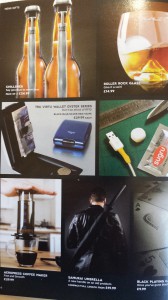Our society genders things. It starts with pink hats and blue hats when we’re babies, continues with LEGO and LEGO Friends when we’re kids and culminates in power tools and handbags when we’re adults. It doesn’t matter how feminist we are, how aware of popular culture and its more problematic elements, it is sometimes difficult to escape internalising some of this social gendering of random objects and concepts. I rarely do a double-take when products I have no interest in (e.g. beer) are marketed in a way specifically aimed at men. I do grumble when items I am interested in are marketed this way, or when, in order to target women, manufacturers think they should make their products pink.
Occasionally, however, someone decides to gender something I never even thought of as gendered in any way before and that serves as a nice reminder of quite how ridiculous the whole concept is. Until last week the Firebox catalog landed on my desk, for instance, I had no idea that I was no longer allowed coffee and related items (filed under “Mens Gifts” – sic) due to my gender identity; also magical fixing putty Sugru; and RFID wallets, possibly because Firebox haven’t worked out that they also come in pink.

I asked whoever was on Twitter some time after midnight last Tuesday if they could think of examples of things that genuinely should be gendered. Here are some of the responses I got: French grammar, sex toys, babies’ nappies, “feminine hygiene products”, “female hormonal contraception”, safe spaces of some kinds. Let’s group these into a few categories and look at them in more detail.
French grammar: languages
Tom Scott has dealt with this beautifully. Enough said.
Sex toys, nappies, tampons, hormonal contraception: objects
More specifically, these are objects designed for specific parts of anatomy: primary and secondary sexual characteristics, body chemistry and organs associated with sex. Let’s at this point remind ourselves of some basic definitions. I’ll go with a slightly modified version of the World Health Organisation definition:
“Sex” refers to the biological and physiological characteristics (…) “Gender” refers to the socially constructed roles, behaviours, activities, and attributes that a given society considers appropriate for (different genders).
The important bit here is that sex and gender are not the same, and that when we say certain objects are only for men or only for women, we are making a statement about socially constructed roles, behaviours or activities, i.e. about gender, not biological sex. Your gender is not defined by your biological sex. If you’re lucky in our cisheteronormative society, your gender identity may match the set of physical characteristics you have, or the gender you were assigned at birth, but there are many people for whom that’s not the case, or whose physical characteristics don’t neatly fit into a binary model.
Looking therefore at things like tampons, sanitary towels and hormonal contraception, there are plenty of men out there who have use for these things. There are also agender or non-binary people who need these products. Likewise sex toys designed to stimulate a particular configuration of genitalia can still be used by people of any gender.
Therefore, stating that a product, even one specifically designed with a particular set of anatomical features in mind, is “for men” or “for women” is extremely problematic. A better approach would be to make direct reference to the anatomical features in question. Something might be for people who have a penis, or a uterus, or breasts. Let’s face it, getting less uptight about discussing bodies can only be a good thing, and shedding oppressive gender norms in the process is a nice bonus.
Safe spaces
Given the global epidemic of gender-based violence, it is understandable that many women in particular feel the need for some gender-segregated safe spaces. Refuges and meeting spaces are good examples here. Having said that, a binary approach to gender can create a whole new set of problems when it comes to safe spaces. Trans women, for instance, are often excluded from refuges or find that they have to meet certain criteria for their gender identity to be accepted. Similarly, agender and non-binary people can be excluded from some safe spaces, even if they are not the threat we need safety from or if they are also affected by the same threat. Queer people who experience domestic abuse can also find it difficult to access safe spaces because our model of domestic abuse is so gendered.
I do accept the need for some safe spaces, but I also believe we need a more nuanced approach to them. I don’t necessarily have a good solution here – and I don’t actually believe there is a one-size-fits-all solution – but here are some of the things I would consider. We need to understand what the threat model is that we are seeking safety from and define our safe spaces as much as possible based on that, rather than on proxies like sex. We particularly need to ensure that in seeking safety we are not policing others’ identities or worse, endangering others.
“But what about pink RFID wallets?” you ask.
Here’s the thing. Pink (okay, magenta) is an awesome colour. It’s bright. It’s cheerful. It goes fantastically well with purple; and black; and all sorts of other colours. If you want a pink RFID wallet, get one. But don’t do it because you’re a woman. And don’t not do it because you’re a man. If you happen to be a marketing exec stop gendering things that have no business being gendered. If your product is designed for particular anatomical features, say so, don’t use gender as a proxy. And if you’re trying to create a safe space, put some thought into it to ensure it is both safe and inclusive.
This post has been brought to you by the Fluff and Inclusion Police.